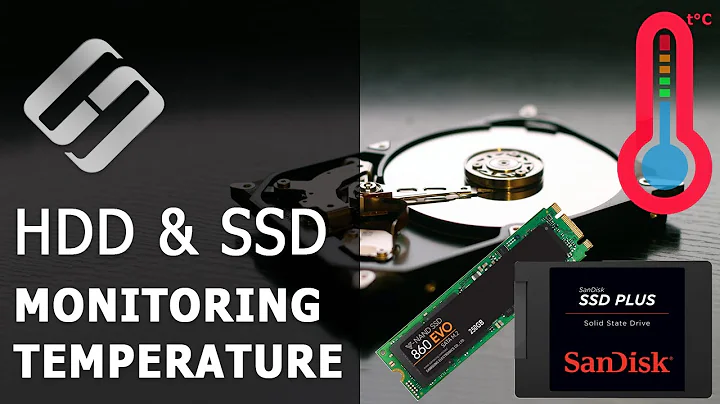What is the safe temperature limit for a consumer SATA hard drive?
Solution 1
37 degrees should not be a problem at all. Naturally, hard drives differ in their specs, some can run hotter than the others. You should check the published specifications of the drives that you have. For example, WD Caviar Black 1TB operational temperature is -0° C to 60° C. Of course, you would not want your drive to run 60°, as it might reduce its life span.
Google published a very interesting study (PDF) about hard drive health and lifespan, based on data collected from their systems (many thousands of hard drives). That study says that:
Overall our experiments can confirm previously reported temperature effects only for the high end of our temperature range and especially for older drives. In the lower and middle temperature ranges, higher temperatures are not associated with higher failure rates. This is a fairly surprising result, which could indicate that datacenter or server designers have more freedom than previously thought when setting operating temperatures for equipment that contains disk drives.
Their graph shows that faulure rate does not go up until drive temperature goes past 45 degrees.
Solution 2
This is only my limited personal experience, but I have run a few drives in the upper 40C without issues over 2-3 years, since I was using a silent enclosure (cooled by a small fan to avoid reaching 50C). At these temps I would assume shorter lifespan and quick death, rather than random data corruption, but I could be wrong. In any case, anything under 40C-42C is just fine.
But don't underestimate other factors likely to play a role in data corruption:
1) The south bridge that houses the IDE/RAID controller chipset is often cooled by a small heat sink only. They tend to run hot in normal conditions, so a rise in ambient temperature due to a lack of case airflow and lots of HDDs could plausibly cause data corruption.
2) RAM or CPU overheating is a common culprit of CRC memory errors, which translates to data corruption. Monitoring CPU temp and performing memory tests is essential when faced with data corruption.
If your current S.M.A.R.T. indicators are fine and don't show uncorrectable sector counts, I would consider the drives safe for use.
Related videos on Youtube
user3376703
I am a former moderator of the Christianity and Biblical Hermeneutics Stack Exchange sites who resigned in protest because I could no longer in good faith support the parent company with my volunteer time when they are enforcing conformity to ideologies openly antagonistic to my beliefs and because their treatment of other volunteer moderators has been reprehensibly poor. I am a scripting language connoisseur, regular expression aficionado, network geek, general lover of Linux and a frequent contributor to open source software. I transitioned to programming from other work because I was too busy automating my own work environment to actually do the other work. I have a hobby interest in cartography. For more see my personal site. Most importantly, my life is defined by the grace of God given to men through Jesus Christ. It is my ambition that everything I do would reflect His glory and point people towards Him.
Updated on September 18, 2022Comments
-
user3376703 over 1 year
Background
My personal desktop system at home has 5 SATA drives racked up inside. Recently my system started failing in odd ways like random kernel panics and I eventually traced it to random degrades on the RAID array. Sometimes I could boot, other times I couldn't and so on. After chasing software issues for a while I finally went to pull the drives and discovered the real reason they were failing: they were hotter than a barbecue on the 4th of July! The front case fan had seized up and the PS fan had a loose power connector caught in its grate so the inside of the case had been cooking.
As a hold over, I found a house fan and got that sucker cooled off. It ran great with everything nice an chill. About this time I learned how to get drive temperature readings from S.M.A.R.T.
for i in a b c d e; do sudo smartctl --all /dev/sd$i | grep Temperature_Celsius doneNow I know that with my case opened an a house fan permanently cleaning out the cobwebs the drives run at 31-32°. A quick test with no ventilation to replicate the failed state shows the drives ran up to the high 40s pretty quickly. I don't know how bad it was during the actual failure or how long its been like that.
With this in mind I replaced the failing fans, added a couple more, upgraded the front one blowing across the drives from 80mm to 120mm and closed it back up. With it standing back upright again the temp range is now generally sitting at 32° on the bottom of the set and 37° at the top.
The Question
What is a general safe operating temperature range for SATA drives? Should 37° be a concern or is drive damage not an issue until after a certain point?
Although the drives seem to test out fine now, how likely is past exposure to heat likely to make them prone to failure now?
-
 Psycogeek over 12 yearsOne of the things I noticed especially with the newer tech cooler running drives, they get a LOT hotter when under hard use. While my greens (for example) are practically cold most of the time I am in there looking/touching, they still get warmed up good when they are working hard. Same thing with the Sata controller chips, Suuuure the Intel controller don't need the big passive sync I added to it, until I Probe it when it has actually been working hard. I am saying that tests (when looking) rarely represent reality when stuff went ary. Everything else was said, they can easily work 50*C
Psycogeek over 12 yearsOne of the things I noticed especially with the newer tech cooler running drives, they get a LOT hotter when under hard use. While my greens (for example) are practically cold most of the time I am in there looking/touching, they still get warmed up good when they are working hard. Same thing with the Sata controller chips, Suuuure the Intel controller don't need the big passive sync I added to it, until I Probe it when it has actually been working hard. I am saying that tests (when looking) rarely represent reality when stuff went ary. Everything else was said, they can easily work 50*C -
 Admin over 5 yearsRelated: serverfault.com/questions/25611/…
Admin over 5 yearsRelated: serverfault.com/questions/25611/…
-
-
 fixer1234 over 9 yearsWelcome. The purpose of this site is to compile high quality questions and answers that people can rely on for reference. A couple of things in your answer may make readers wonder. You discuss research and testing. If this is published, it would be valuable to cite that. Your use of the word "unknown" raises a question about your qualifications. It would help to describe what known factors you ruled out and what "usual" problems cause over-heating. Describe your tests and how many drives you base your conclusion on so people can understand the scope.
fixer1234 over 9 yearsWelcome. The purpose of this site is to compile high quality questions and answers that people can rely on for reference. A couple of things in your answer may make readers wonder. You discuss research and testing. If this is published, it would be valuable to cite that. Your use of the word "unknown" raises a question about your qualifications. It would help to describe what known factors you ruled out and what "usual" problems cause over-heating. Describe your tests and how many drives you base your conclusion on so people can understand the scope.




